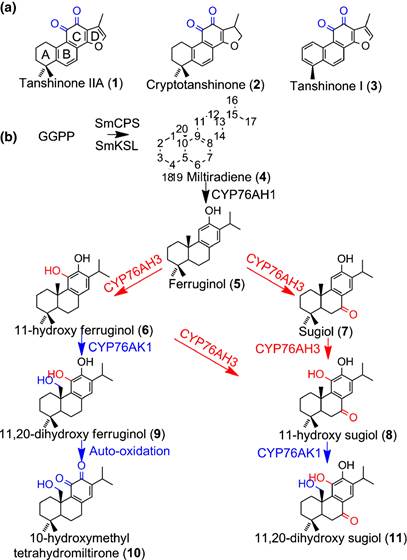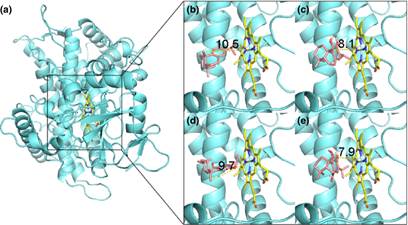


12月18日,中国中医科学院中药资源中心黄璐琦院士带领的功能基因研究团队和中科院大连化学物理研究所赵宗保研究员带领的生物质高效转化研究团队合作, 在植物源萜类化合物的生物合成途径研究方向取得新进展,相关结果在线发表于《New Phytologist》。
植物源萜类化合物具有广泛的生物活性,依赖于植物体的传统生产方式是目前推广应用的瓶颈之一,而依赖于生物合成途径解析的代谢工程和合成生物学是改变这一现状的有效方式。丹参酮属于松香烷型二萜化合物,是我国传统中药丹参的主要脂溶性活性成分,具有抗菌、抗氧化、抗炎、抗肿瘤等活性。前期,黄璐琦院士课题组与大连化学物理研究所赵宗保研究员课题组、美国Iowa State University的Reuben J. Peters教授课题组、中科院遗传与发育生物学研究所王秀杰研究员课题组、中科院上海辰山植物科学研究中心陈晓亚院士课题组、中科院天津工业生物技术研究所张学礼研究员课题组等合作,发现了催化生成丹参酮基本碳骨架-次丹参酮二烯的两个萜类合酶(Org Lett, 2009, 11(22): 5170),构建了高产次丹参酮二烯的酵母工程菌株(J Am Chem Soc, 2012, 134(6): 3234; Biotechnol Bioeng, 2012, 109(11): 2845),并利用C-13同位素标记技术,确定了该碳骨架结构在丹参酮生物合成中的作用,在此基础上又发现了催化次丹参酮二烯生成代谢中间产物铁锈醇的关键酶基因-CYP76AH1,并构建了高产铁锈醇的酵母工程菌(Proc Natl Acad Sci U S A, 2013, 110(29): 12108.)。
近期,黄璐琦院士课题组与合作者们进一步利用比较转录组学技术筛选得到2个参与丹参酮生物合成途径的细胞色素氧化酶P450基因,通过基因表达和体外酶促活性筛选及RNA干扰分析,发现CYP76AH3和CYP76AK1的功能均具有冗杂性,CYP76AH3可催化铁锈醇的C-7和C-11两个碳活性位点生成11-羟基铁锈醇、柳杉酚和11-羟基柳杉酚,CYP76AK1可羟化11-羟基铁锈醇和11-羟基柳杉酚这两个化合物C-20分别生成11,20-二羟基铁锈醇和11,20-二羟基柳杉酚,11,20-二羟基铁锈醇会自氧化形成丹参酮邻苯二醌结构10-羟甲基四氢丹参新酮。研究人员将新发现的两个功能基因整合到前期构建的高产铁锈醇的酵母工程菌中,获得了能同时产生这6种二萜产物的酵母工程菌。本研究为丹参酮相关P450基因发掘、生物合成途径解析和微生物生产奠定了基础。
该研究得到了国家自然科学基金委、863计划等的资助。(来源:中国中医科学院 马晓惠)
Cytochrome P450 promiscuity leads to a bifurcating biosynthetic pathway for tanshinones
Abstract Cytochromes P450 (CYPs) play a key role in generating the structural diversity of terpenoids, the largest group of plant natural products. However, functional characterization of CYPs has been challenging because of the expansive families found in plant genomes, diverse reactivity and inaccessibility of their substrates and products. Here we present the characterization of two CYPs, CYP76AH3 and CYP76AK1, which act sequentially to form a bifurcating pathway for the biosynthesis of tanshinones, the oxygenated diterpenoids from the Chinese medicinal plant Danshen (Salvia miltiorrhiza). These CYPs had similar transcription profiles to that of the known gene responsible for tanshinone production in elicited Danshen hairy roots. Biochemical and RNA interference studies demonstrated that both CYPs are promiscuous. CYP76AH3 oxidizes ferruginol at two different carbon centers, and CYP76AK1 hydroxylates C-20 of two of the resulting intermediates. Together, these convert ferruginol into 11,20-dihydroxy ferruginol and 11,20-dihydroxy sugiol en route to tanshinones. Moreover, we demonstrated the utility of these CYPs by engineering yeast for heterologous production of six oxygenated diterpenoids, which in turn enabled structural characterization of three novel compounds produced by CYP-mediated oxidation. Our results highlight the incorporation of multiple CYPs into diterpenoid metabolic engineering, and a continuing trend of CYP promiscuity generating complex networks in terpenoid biosynthesis.
原文链接:http://onlinelibrary.wiley.com/doi/10.1111/nph.13790/pdf



